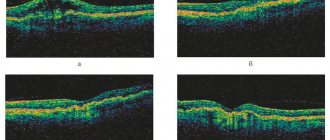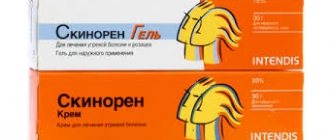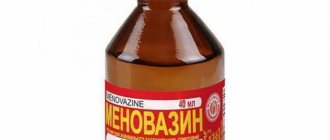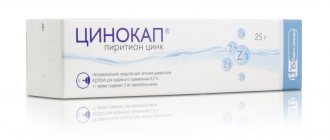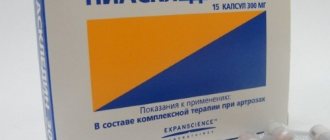| Composition and release form How the drug works When prescribed (indications) How to use (dosage) Contraindications for use Side effects of use | Overdose symptoms Drug interactions What to pay attention to Retinalamin analogs Prices in pharmacies Reviews from people who have used it |
Directions for use and dosage
Adult patients
To prepare the Retinalamin solution, the powder is dissolved in water for injection, 0.9% saline solution of sodium chloride or 0.5% solution of procaine (novocaine).
For the treatment of taperetinal abiotrophy, diabetic retinopathy, central retinal dystrophies, compensated open-angle glaucoma, Retinalamin solution is prescribed intramuscularly or parabulbarly in an amount of 5–10 mg once daily. The course of treatment can last 5 - 10 days, it can be repeated after 3 months or six months.
For myopic disease, Retinalamin solution is administered parabulbarly once daily at 5 mg for up to 10 days.
Children 1–5 years old
In the treatment of central retinal dystrophies and taperetinal abiotrophy, injections of the drug are prescribed parabulbarly or intramuscularly once, 2.5 mg daily.
Children 6–18 years old
In the treatment of central retinal dystrophies and taperetinal abiotrophy, parabulbar or intramuscular injections of the drug are prescribed daily, in a single dose of 2.5 or 5 mg. The course of treatment is up to 10 days, it can be repeated after 3 months or six months.
Composition and release form
The drug is available in the form of a powder (lyophilisate), which is used to prepare a drug solution for parabulbar or intramuscular administration. The color of this porous mass is white or with a slight yellowish tint. The total mass of the substance in each bottle is 22 mg.
One bottle contains:
- Retinalamin, which is a purified water-soluble polypeptide that is isolated from the retina of the eyeball of livestock, in an amount of 5 mg.
- Glycine, which is a stabilizer, in the amount of 17 mg.
Five bottles are placed in a package made of foil and PVC film. Next, two such packs are packed in a cardboard box along with paper instructions.
Instructions for use of Retinalamin
This medication restores the structure of damaged retinal tissue and is actively used for systemic use by modern ophthalmology. Retinalamin increases immune functions, demonstrates protective properties in relation to the vascular epithelium, and has a beneficial effect on the coagulation of local blood flow. This medication has a local effect on the source of pathology, positive dynamics are observed immediately after the start of the course.
Composition and release form
Retinalamine is presented as a lyophilisate, which is produced in the form of a homogeneous white or almost white powder, necessary for the preparation of a medicinal solution. The method of administering the drug is intramuscular and parabulbar. One package contains 2 or 5 bottles. A stable therapeutic effect is ensured by the interaction of substances that are collected in the chemical composition of Retinalamin:
| Active ingredient | Excipients |
| livestock retinal polypeptides (5 mg) | glycine (17 mg) |
pharmachologic effect
This is a tissue repair stimulator, which has an exciting effect on retinal cells and photoreceptors, improves the functional interaction of the membrane elements, and restores the light sensitivity of the affected organ of vision. Under the influence of polypeptides from the retina of livestock eyes, it is possible to quickly normalize vascular permeability, reduce the intensity of the inflammatory reaction, and accelerate reparative processes in pathologies and injuries of the retina.
It is not possible to conduct a full pharmacokinetic analysis of the active components. Among the positive aspects of conservative treatment with Retinalamin, it is necessary to highlight the following actions of a complex of water-soluble polypeptide fractions with a molecular weight of up to 10,000:
- improves eye cell metabolism;
- stimulates intracellular protein synthesis;
- activates the functions of retinal cell membranes;
- successfully fights inflammation and cell dystrophic processes;
- regulates lipid oxidation processes;
- provides the retina with the required vitamins;
- increases visual acuity after the first course;
- optimizes energy processes.
Indications for use
This medication is often used in the complex treatment of retinal pathologies. The main indications for the use of Retinalamin are presented in the following list:
- primary open-angle glaucoma (compensated);
- rhegmatogenous and traumatic retinal detachment;
- central retinal dystrophy;
- myopic disease (myopia);
- diabetic retinopathy;
- taperetinal abiotrophy (central and peripheral hereditary atrophy);
- polyneuropathy;
- central retinal dystrophy of inflammatory and traumatic origin.
Drug interactions
Competent experts strongly do not recommend mixing several solutions in one bottle at once. As a result of such manipulations, the desired therapeutic effect of the drug is significantly weakened, and side effects cannot be ruled out. Otherwise, drug interactions with Retinalamin have not been recorded in practice and are not reflected in the detailed instructions.
special instructions
It is important to know that the prepared single dose of medicine must be consumed in a timely manner and not stored in the refrigerator. Taking Retinalamin does not affect psychomotor reactions, so during the treatment period you can drive vehicles, engage in intellectual activity, and work associated with increased concentration.
- First aid for cardiac arrest
- Treatment of pulmonary tuberculosis
- Sberbank social card - who is entitled to it. How to receive and top up the limit of a Sberbank social card
Indications
Retinalamine is used in the complex treatment of various retinal dystrophies (peripheral and central dystrophies of various origins), for diabetic retinopathy, for the treatment of age-related macular degeneration (dry and wet form), hereditary retinal dystrophies (pigmentary degeneration, retinal abiotrophy, Stargardt disease).[4,5 ,6] Due to its neuroprotective effect (protection of retinal neurons from the effects of damaging factors), retinalamine has found use in the treatment of patients with primary open-angle glaucoma.[7]
Also, courses of injections are prescribed after surgical treatment of retinal detachment and tears.[8]
Contraindications
The use of Retinalamin is contraindicated for:
- individual intolerance and hypersensitivity;
- minors, since there is not enough data to confirm its effectiveness in primary compensated open-angle glaucoma, myopic disease or diabetic retinopathy;
- under the age of one year with taperetinal abiotrophy (peripheral or central) and with central retinal dystrophy caused by inflammation or injury;
- during pregnancy, since there are no results of studies of safety and effectiveness in this category of patients.
During treatment with the drug, breastfeeding should be stopped.
Cost of treatment
- Intramuscular injection (without the cost of medicine) - 300 rubles
- Parabulbar injection (without the cost of medicine) - 700 rubles
- Introduction into the sub-Tenon's space together with revascularization of the posterior part of the eye - 23,500 rubles
ATTENTION! The exact cost of treatment can only be determined after an in-person consultation, when the condition of the patient’s eyes is determined and a treatment plan is drawn up.
List of sources
- Instructions for use of the drug "Retinalamin"
- Khavinson VKh, Malinin VV, Trofimova SV, Zemchikhina VN. Inductive activity of retinal peptides. Bull Exp Biol Med. 2002 Nov;134(5):482-4.
- Erichev V.P., Petrov S.Yu. Structural and functional changes in the retina as a criterion for assessing neuroprotective therapy for glaucoma Modern technologies in ophthalmology No. 4 2020
- Zhuravleva L.V., Peptide bioregulators and antioxidants in the treatment of patients with Stargardt abiotrophy, IX Congress of Russian Ophthalmologists. Moscow, 2010.
- Korotkikh S.A., Knyazeva E.S., Chervyakova E.S. Peptide neuroprotection in the treatment of age-related macular degeneration of the retina. East - West 2011
- Makashova NV, Vasil'eva AE, Morozova NE, Ronzina IA. . Vestn Oftalmol. 2014 Jul-Aug;130(4):71-6, 78-80.
- Sabirova D.B., Tulakova G.E., Ergasheva D.S. Complex treatment of diabetic maculopathy using the peptide bioregulator “Retinalamin” and laser coagulation of the retina. East - West. No. 2 2017
- Ivanov S.V., Mashkovtsev V.M., Cherygova E.G., First experience of using retinalamine in the complex treatment of patients with rhegmatogenous retinal detachment. Modern technologies for the treatment of vitreoretinal pathology - 2010
- Shiveleva O.G. Results of the use of retinalamine in the treatment of age-related macular degeneration in outpatient settings East - West 2011
Material prepared by:
Ophthalmologist Dmitry Alekseevich Sagonenko
Price of the drug Retinalamin
The cost of the drug "Retinalamin" in Moscow pharmacies starts from 3,500 rubles.
In our ophthalmology center you can take courses of parabulbar (injections into the eyes) and intramuscular injections of the drug. The cost of a parabulbar injection is 700 rubles, an intramuscular injection is 300 rubles. (excluding the cost of the medicine).
In addition, all types of effective medical, physiotherapeutic and surgical treatment of retinal diseases are available at the Moscow Eye Clinic.
pharmachologic effect
Retinalamin contains a complex of polypeptide fractions, soluble in water, the molecular weight of which does not exceed 10 kDa.
It stimulates tissue separation and has a pronounced effect on the cellular elements of the retina and photoreceptors. The use of the drug helps improve the functional interaction between the outer segments of photoreceptors and the pigment epithelium, which are disrupted during degenerative processes. In addition, Retinalamin restores the normal permeability of the vascular wall, stimulates regeneration processes in case of injury or disease of the retina, and also accelerates the restoration of the sensitivity of the light receptors of the retina.
The mechanism of action of the drug is due to its metabolic activity. It improves metabolism in the cells of the eyeball, accelerates intracellular protein synthesis, restores the function of surface membranes, regulates the reaction of lipid peroxidation, thereby helping to normalize energy processes in the tissues of the eye.
Due to the fact that Retinalamin contains several different fractions of polypeptides, this drug is difficult to study for distribution in the body.
Retinalamin analogs
For abiotrophy, myopia and other eye diseases with a sharp decrease in vision, it is recommended to consult a specialist for individual advice at the first symptoms. If the use of Retinalamin causes side effects or does not improve visual acuity, the ophthalmologist introduces a replacement. Analogs of this medication are presented in the following list:
- Vidisik. This is an eye gel recommended for dry eye syndrome. You need to put 1 drop of the composition into each eye up to 35 times a day. Course – 5-10 days.
- Artelak Splash. Eye drops to moisturize, nourish and relieve symptoms of inflammation. The medicine should be used for 5-10 days, several times a day (1 drop per eye).
- Korneregel. An eye gel that needs to be placed into the conjunctiva. In 1 day, you are supposed to perform 3-5 procedures, to be treated until the unpleasant symptoms completely disappear and the visual fields expand.
- Okoferon. This is a medicinal liquid for the eyes, which must be instilled 2 drops every 2 hours. The course of treatment is up to 10 days.
- Systane. This is a rehydrant in the form of a sterile solution, which is instilled 1-2 drops into each eye until the alarming symptoms are completely eliminated.
- Ophtolic. According to the instructions for use, 1-2 drops should be dropped into each eye in turn, then blink thoroughly.
- Opt. It is a substitute for natural tears, especially important for dry eye syndrome. It is required to instill 1 drop for each eye up to 5 times a day for a week.
Parabulbar injections
When prescribing a course of parabulbar injections with Retinolamine, they are performed by a specialist with sufficient experience in such procedures in a specially equipped clinic room or in a sterile operating room. Injections of the drug do not require special preparations.
To obtain an injection solution, the leophilisate of the drug is diluted using an isotonic solution or procaine (0.5%) and water for injection. Administration is carried out with a disposable syringe with a slightly blunted needle. During the procedure, the needle enters percutaneously into the lower eyelid (outer edge) and advances approximately 1 cm in depth. The required dose of the drug is injected into the space at the back wall of the eyeball.
Retinolamine solution cannot be stored, therefore, after the injection, its remains are disposed of.
